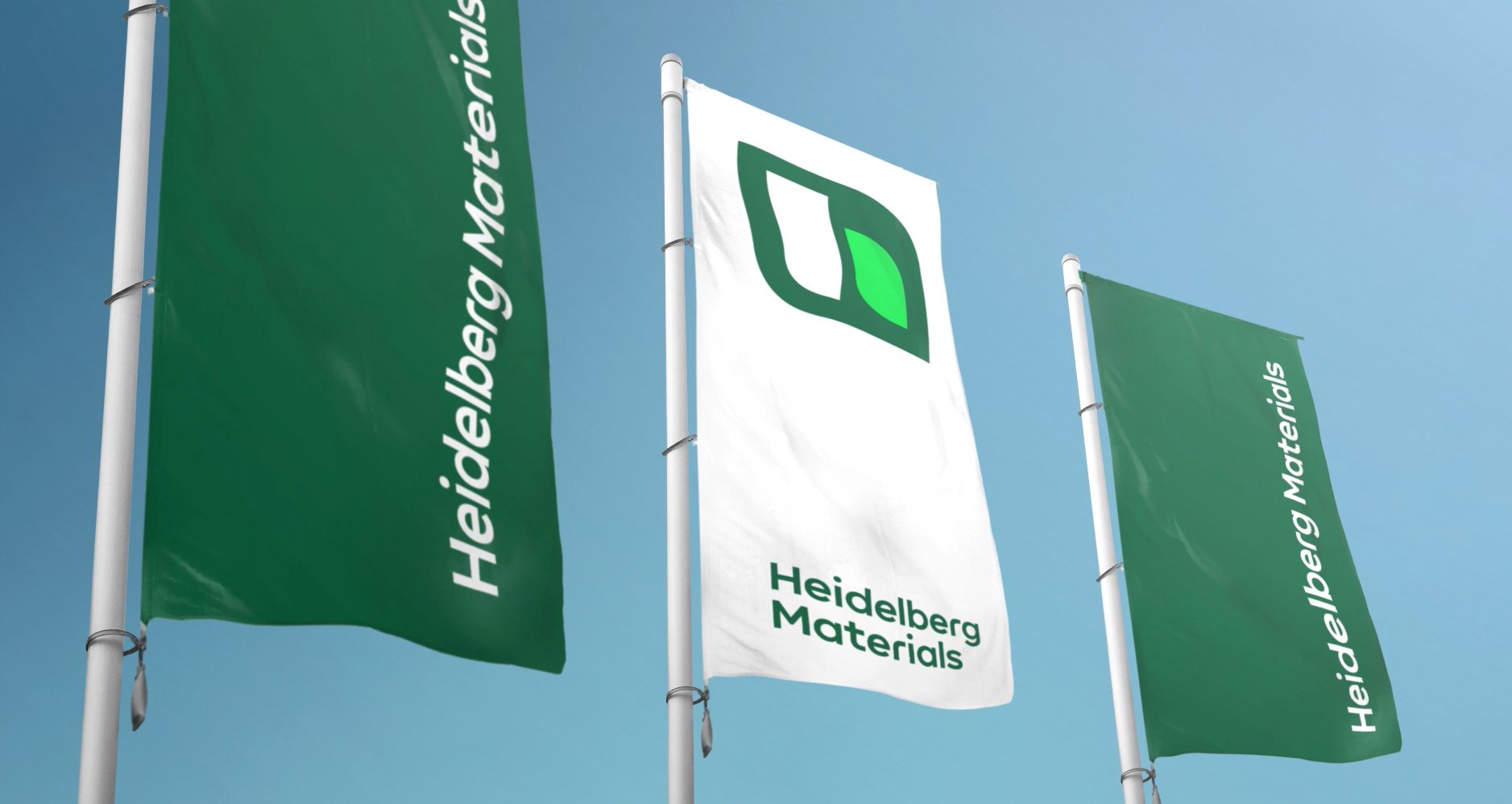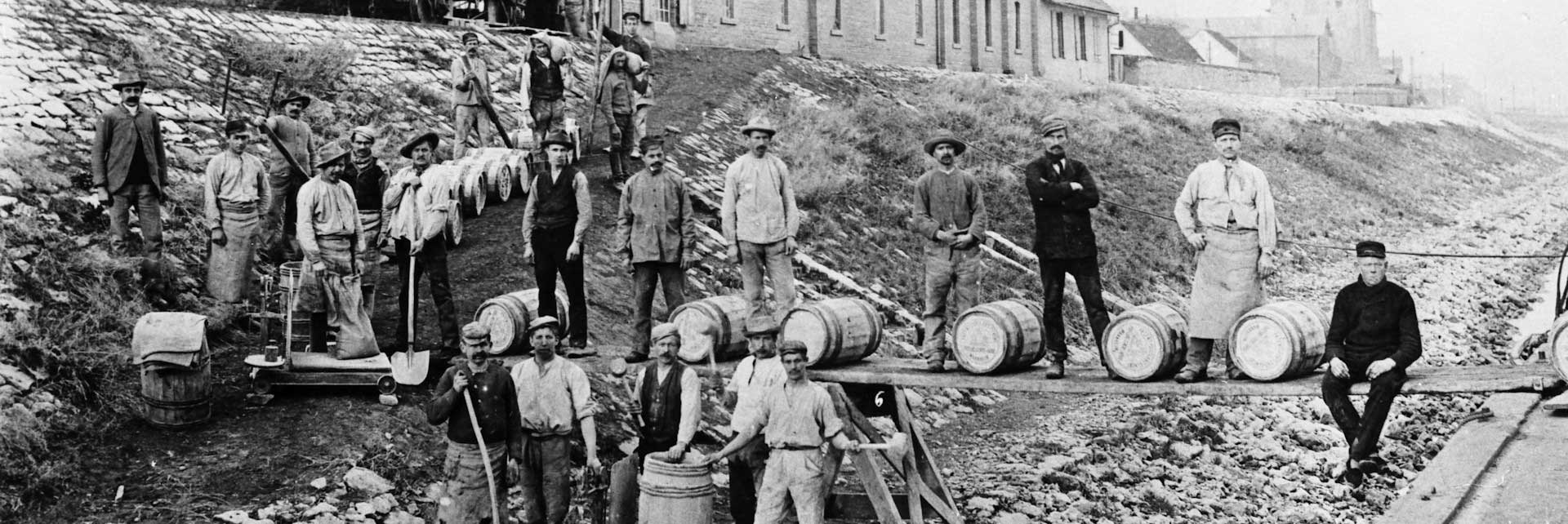Barrel loading at the Mainz-Weisenau factory, around 1900.
The new head office building at Berliner Strasse 6 in Heidelberg, 1963.
New Heidelberg Portland-Cement plant in Leimen, 1900.
150 Years of Heidelberg Materials
This account of the 150-year history of Heidelberg Materials traces the origins of the company. Starting with the company's founder Johann Philipp Schifferdecker, the view extends to the challenges of today.
Company foundation
Around 1850, Portland cement was an emerging product. Developed in Great Britain, Portland cement also became a sought-after product in the German Confederation and later in the German Empire. In the middle of the Gründerzeit, in 1873, the trained beer brewer Johann Philipp Schifferdecker built a Portland cement plant in Heidelberg, which operated under the name "Portland-Cement-Werk Heidelberg, Schifferdecker & Söhne". A major fire in 1895 meant a severe setback for the ambitious company. As the city of Heidelberg prevented the rebuilding of the plant due to the dirt and noise pollution, the largest Portland cement plant in the German Empire was built in neighbouring Leimen.
Family ties
Johann Philipp Schifferdecker's son Paul and son-in-law Rudolf Heubach converted the company into a public limited company in 1889. The family was represented on the supervisory board until the 1930s. In 1875, Friedrich Schott had joined the company as a works chemist and had contributed to decisive improvements in the cement produced. He later became Chairman of the Managing Board and then moved to the Supervisory Board. Several of Schott's relatives were also employed in the company. His brothers Adolf and Otto took on important functions in the company management and on the Supervisory Board. Friedrich Schott's sons, Otto and Ehrhart, were also active in the company. Otto was killed in the First World War, Ehrhart was plant manager in Leimen, a member of the board of directors and led the company after the Second World War.
The company quickly developed into the leading group in southern Germany. Other factories with which the Heidelberg company had merged or had shareholdings were also firmly in family hands. There were excellent relationships with the Kirchhoff family in Lengfurt, the Spohn family in Blaubeuren and the Lude families in Kiefersfelden and Nürtingen. These very good relations also contributed to the excellent integration of the factories into the Heidelberg parent company.
Portland cement as a bestseller
The manifold advantages of Portland cement ensured that the new product was in great demand within a very short time. As a result, sales rose continuously. During the First World War, sales collapsed because the cement industry was not considered important for the war effort and therefore did not receive preferential coal allocations. Shortages were noticeable everywhere at the end of the war. Nevertheless, sales volumes increased again during the Weimar Republic, although the hyperinflation in 1923 and the world economic crisis from 1929 caused serious problems. The National Socialists ensured a rapid upswing in the cement industry, as large quantities of cement were needed for the prestige buildings in Berlin and Nuremberg, as well as for the massive rearmament. During the Second World War, the cement industry was considered vital to the war effort and had to fulfil the requirements of the economic plans. In order to meet these, forced labourers and prisoners of war were also used in the Heidelberg company.
After the end of the war in 1945, cement was also in demand in large quantities for reconstruction. The economic miracle also enabled the development of new special products. The construction boom also marked the beginning of the success story of bulk cement. The oil price crisis and its consequences put an abrupt end to the upswing. In order to be better prepared against such crises in the future, the company took its first step towards internationalisation and took over the Lehigh Portland Cement Company in the US in 1977.
Diversification and internationalisation
In the mid-1990s, Heidelberger Zement AG positioned itself more broadly and acquired CBR and Scancem. Further acquisitions of Hanson PLC in 2007 and Italcementi in 2016 led to leading positions in the world market in the cement and concrete sectors. As a result of these acquisitions, Heidelberg Materials is now a global company with 51,000 employees. At the same time, new challenges need to be mastered. Currently, the focus is on digitalisation and the reduction of carbon dioxide emissions. Innovation, down-to-earthiness and market leadership – Heidelberg Materials has stood for this for 150 years.
- Der Heidelberger Portländer. Beiträge zur Unternehmensgeschichte und Unternehmenskultur (Heidelberg’s Portland cement-makers: articles on the company’s history and corporate culture), volume 15
-
The History of Heidelberg Materials
The development of a company from southern Germany into an international
Group (edited by Heidelberg Materials AG)Dietmar Cramer, Eszter Harsányi
Copyright © 2023 Heidelberg Materials AG
Berliner Straße 6, 69120 Heidelberg, GermanyCover photograph: Mill building with shaft kilns
on the site of Bergheim mill, 1875.



